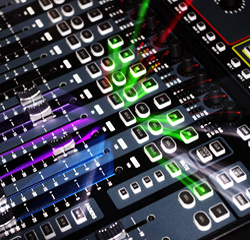
Roland Systems Group has long been addressing many key aspects of console and integration design, perhaps best encapsulated in M200i.
It’s compact and offers considerable iPad control, joined by a host of recording capabilities. Multi-channel live recording, using the latest V2.0 REAC driver in concert with SONAR X3, is included with all V-Mixing Series models, enabling direct capture of up to 40 audio channels to a PC.
In addition, any two of the main, aux or matrix outputs can be recorded directly to a USB memory stick. Roland also offers straightforward “plug and play” 48-track recording via the REAC protocol to R-1000 digital recorder/players—and—recording via MADI can be accomplished using the MADI bridge. It should also be noted that the popular Roland M-48 personal mixing system easily integrates with V-Mixing consoles.
The new Midas M32 has visual appeal via a cool industrial aesthetic, and getting to the audio heart of the mater, includes proprietary “Acoustic Integration” that provides streaming of up to 16 channels of digital audio and control data to Turbosound iQ Series loudspeakers—all on a single Cat-5 cable. You can even set loudspeaker presets remotely.
And in turn, iQ Series models include what the company calls “True Physical Modeling” of some of the most popular loudspeakers on the market, and this too can be remotely controlled via the M32, allowing users to apply different settings in real time from the mixing desk.
The M32 also includes a high-resolution 100-band RTA that provides bar and spectrograph views so we can see what we’re hearing. Users can switch between the large RTA view, displaying any available signal in full screen resolution, or a combined view with the RTA view shown above each of the channel and bus EQ curves. Additionally, the RTA can be displayed on top of the 31-band graphic EQs in the FX rack.
Mackie took the market by storm with the DL1608, the first mixer available that utilized a user-supplied iPad for control—no onboard faders or knobs except for the input trims and headphone volume.
A neat thing about this concept is that an iPad can be docked or used wirelessly to control all mix parameters, and multiple iPads can be used by performers to access their own personal monitor mixes. Another cool aspect is that when docked, a stereo recording from the masters can be made to the iPad, just like the board tapes of old.
By the way, Mackie has recently announced the DL32R, a new 32-input rack-mounted mixer that will be officially unveiled on October 15. It too will utilize a wireless iPad for control, and most assuredly much more. We’ll provide the details as soon as they’re available.
Senior contributing editor Craig Leerman is the owner of Tech Works, a production company based in Las Vegas.
